Cite this document
(“Finance and accounting essay: PLC report Essay Example | Topics and Well Written Essays - 3000 words”, n.d.)
Retrieved from https://studentshare.org/finance-accounting/1404220-next-plc-report
Retrieved from https://studentshare.org/finance-accounting/1404220-next-plc-report
(Finance and Accounting Essay: PLC Report Essay Example | Topics and Well Written Essays - 3000 Words)
https://studentshare.org/finance-accounting/1404220-next-plc-report.
https://studentshare.org/finance-accounting/1404220-next-plc-report.
“Finance and Accounting Essay: PLC Report Essay Example | Topics and Well Written Essays - 3000 Words”, n.d. https://studentshare.org/finance-accounting/1404220-next-plc-report.


